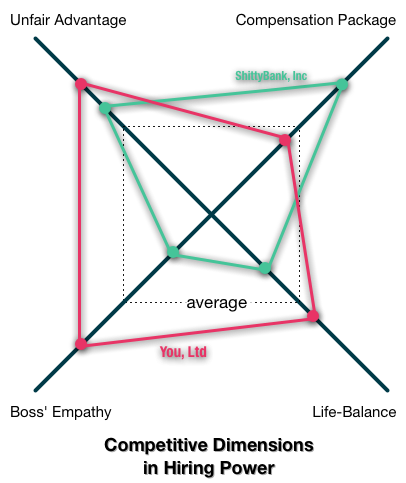Say you’re a startup founder or working for a startup and tasked to hire new employees. You’ve searched high and low for good people to work for you, exhausted your Monster résumé collection and tried scavenging LinkedIn, Google+, and even Facebook but you couldn’t find the high-quality engineers that you need for your venture. Sights of despair are glimmering. Then what?
Lets face it, working in startups as an employee has many downsides in addition to the usual downsides of any job. These are among those “extra” downsides:
- lower salary or total compensation package (because you’re still not making money)
- longer hours (because you’re pressed with time-to-market and/or investors breathing down your neck)
- egocentric bosses cum founders (that’s normal for the typical entrepreneur since they see themselves as visionaries)
To make things worse, headhunters are often even more clueless about these downsides when promoting their vacancies. Here is an excerpt of one message I received recently – name concealed to protect the guilty.
“Dear Sasmito, I am a technologist recruiter at XXXXX. I have an important position for a Senior iOS Developer in an exciting and highly successful social media firm in Singapore that has the leadership of Silicon Valley veterans and the financial backing of private global investors and the Singaporean government. This is a unique position that will see you creating a brand new social media platform that will connect its 16 million+ users globally. If this is something you would like more information on, I will be keen to share more details. I look forward to hearing from you.”
Granted this e-mail doesn’t explicitly say “startup” – but to someone who regularly receives these recruiter pitches, it’s clearly visible that the vacancy is not coming from an established company. This recruiter even writes subjective superlatives like “exciting and highly successful” and “has the leadership of Silicon Valley … financial backing of government …” without quoting anything verifiable.
You should also see that the above e-mail doesn’t say anything that touches any of the three concerns I’ve said earlier. As Amy Hoy put it, startups are one long con – experienced engineers aren’t likely to fall to that trick again (because being experienced means that they’ve probably have been gullible before).
Then how can you attract good-skilled people to your startup? For a start, you’ll need to address the downsides of working for a startup. That should cover the hygiene part (of Fredreick Herzberg’s motivation-hygiene theory). Then you should work on your unfair advantage, which will entice people to work for you (this is the motivation part of Herzberg’s theory).
Let me show you a framework how you can compete for employees with MegaCorps. Consider these four factors:
- Your unfair advantage What can your company provide that other jobs and personal projects cannot? Is it working in latest technology? Access to eager early adopters? Deep-pocketed angel investors? If your tech is mostly open-source (or can be acquired with $2000 or less), then technology won’t be your edge in luring employees since they can use their personal time to work on those. What kind of technologies that will attract high-quality engineers that is an unfair advantage? Think theLarge Hadron Collider, brain-computer interface, or deep-sea exploration. If you’re not working in domains where the technology barrier to entry is high then you better compensate on the other factors.
- How do you address life-balance issues? Remember that these people have other priorities than solely their work, otherwise they’ll run their own startups. When times are good, MegaCorps usually has excellent work/life balance. However we’re not completely out of the recession yet thus some of these large corporations are deliberately understaffing their operations (which often strains work/life balance). Also I often see consulting companies (and companies that charges a margin of the employees’ time in general) are usually eating up their employees’ personal life. These are two opportunities that you can jump in to compete with more established corporations on work/life balance.
- Boss’ empathy (or working environment) If you’re a startup founder, have you ever been an employee? Have the experience made you humbler? Can you emphatize with your employees? Never expect that a mere employee will be working as hard as you are since they don’t own the companyand can’t expect much capital payout. Sadly this problem does not solely belong to startups. EvenMegaCorps has their share of overly-aggressive bosses. Remember that the boss shapes the culture of her division and thus her attitude will certainly affect how people that reports to her work and relate to each other.
- Compensation Last but not least, can you offer a competing salary that they can earn (or currently earning) at a MegaCorp? If not, what other non-financial perks that you offer to make up the difference? (note: “working with you” doesn’t count as a perk – that’s just your megalomaniac voice talking). This is crucial since even though money is rarely a primary motivation, substandard salary motivates employees to look for better pay elsewhere. If you’re paying largely below what your competitors are paying, even a slight dissatisfaction in other areas could easily crank up your turnover rate.
You can plot the above four factors on a plane to gauge your position relative to your competitors. This is a radar chart of four dimensions with each dimension representing one of the competitive factors listed above. You mark a point in the middle of each dimension line as “average”. Going outwards of those “average” marks means that it is “above average” and inwards means that the factor is “below average”.
Then you draw your estimate of how each of your competitors fares in each factor. Plotting a large publicly-traded MegaCorp is easier since there is plenty of publicly-available data that you can find about such company. Then you need to plot your own company and see how it fares against your competitors in terms of hiring power.
In the example diagram I’ve provided a hypothetical large bank that I call ShittyBank. Being a financial company, they can afford to pay their employees at significantly above market rate, as shown by the “Compensation Package” axis in the diagram. However ShittyBank is known to have a predatory culture and need to do a lot of busywork, hence the low rankings in the “Boss’ Empathy” and “Life-Balance” axes. Since they have access to a large pool of customers, they have an above-average “unfair advantage” that smaller banks cannot match (think engineers interested in data-mining or large-data problems – ShittyBank’s large customer base offers the big data that they need to play with).
Similarly, I plotted “You, Inc” as an example of how you can analyze yourself to compete against ShittyBank.
This article was written by Sasmito Adibowo, distinguished author at Making the Switch. see more.






























